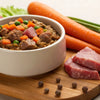How Much Dog Food Can a Puppy Eat? Your Ultimate Guide to Optimal Puppy Nutrition
- Houndsy
Table of Contents
- Introduction
- Understanding Puppy Nutritional Needs
- Creating a Feeding Schedule
- Managing Portion Control
- Choosing the Right Food
- Transitioning to Adult Food
- Conclusion
- Frequently Asked Questions
Introduction
Did you know that around 60% of dogs are either overweight or obese, according to the Association for Pet Obesity Prevention? This startling statistic highlights the importance of proper nutrition, especially in the formative stages of a puppy's life. As responsible pet owners, we all want our furry companions to thrive, and understanding how much dog food a puppy can eat is crucial to achieving this goal.
As puppies grow, their nutritional requirements shift significantly. Different breeds, sizes, and growth rates play pivotal roles in determining the appropriate amounts of food needed to keep our little ones healthy and growing. In this blog post, we will dive deep into the intricacies of puppy nutrition, addressing several key questions: How much food should your puppy eat daily? What type of food is best for their developmental needs? How can you formulate a feeding schedule that works with your daily routine?
By the end of this guide, not only will you understand how much dog food your puppy requires, but you'll also feel equipped to create a consistent feeding routine that enhances both their physical and emotional well-being. Let's embrace these insights and make the feeding ritual a delightful experience—one that aligns seamlessly with our design-driven philosophy at Houndsy to elevate your puppy's dining experience while removing the hassle from your daily routine.
Understanding Puppy Nutritional Needs
Nutritional Essentials
Puppy foods are formulated to meet the distinct needs of growing dogs. Here’s what puppies typically require in their diet:
-
Proteins: Essential for muscle growth and tissue development, a puppy's food should contain a higher percentage of protein than adult dog food. Look for formulas that offer about 27% protein.
-
Fats: Healthy fats are vital for energy, brain development, and coat health. They also help puppies absorb essential vitamins. Quality puppy food contains about 16% fat.
-
Carbohydrates: Puppies require carbohydrates to sustain their energy levels throughout the day. However, they should be provided in moderation.
-
Vitamins and Minerals: Calcium, phosphorus, and other crucial nutrients are necessary for the healthy development of bones and teeth.
-
DHA: This omega-3 fatty acid is important for brain and vision development.
Determining the Right Amount
The general rule of thumb for how much to feed a puppy is to target 5-6% of their estimated body weight in adult form. However, this is not a one-size-fits-all guideline. You must consider specific factors like breed size, activity level, and current health status.
Here’s a breakdown of how puppies of different weight categories should be fed:
-
Small Breeds (Up to 25 lbs in adulthood):
- 3-4 months: 1-3 cups daily, divided into three meals.
- 5-12 months: Gradually decrease to 1-2 cups daily, split into two meals.
-
Medium Breeds (25-50 lbs in adulthood):
- 3-4 months: 1.5-3 cups daily.
- 5-12 months: 2-4 cups daily.
-
Large Breeds (50 lbs and over):
- 3-4 months: 2-4 cups daily.
- 5-12 months: 3-5 cups daily, depending on activity level.
Creating a Feeding Schedule
Tailoring with Age and Weight
Puppies grow at different rates depending on their breed and size. Therefore, it’s crucial to tailor meal plans accordingly. A general feeding schedule could look like this:
- Newborn to 4 weeks: Puppies should still be nursing.
- 4-12 weeks: Transition to puppy food with four meals a day to maintain energy.
- 3-6 months: Gradually reduce to three meals a day; monitor growth.
- 6-12 months: Transition to two meals a day as they approach adulthood.
Clickable Sample Feeding Schedule by Age
| Age | Meal Count | Total Food (per day) |
|---|---|---|
| 1.5-3 months | 4 | ½ - 2⅔ cups |
| 4-5 months | 3 | ⅔ - 3¾ cups |
| 6-8 months | 2 | ½ - 6⅓ cups |
| 9-11 months | 2 | ½ - 7 cups |
| 12-24 months | 2 | 2 - 11 cups based on adult size |
Tip: Always remember to consult the feeding guidelines specified on the food packaging and adjust according to your veterinarian’s recommendations—this ensures that your puppy receives the best care tailored to their needs.
Managing Portion Control
Measuring for Success
To achieve successful portion control and avoid the common pitfalls of overfeeding, consider these strategies:
-
Use a Measuring Cup: Ensure accuracy by measuring the food you provide, rather than eyeballing it.
-
Feed at Set Times: Establish a feeding schedule to help regulate your puppy's digestion and make it predictable for them. Consistency is key!
-
Monitor Weight: Regularly check your puppy’s weight and make adjustments to their food intake as needed. If they seem to be gaining too much weight, carefully reduce portion sizes.
-
Caloric Count: Keep in mind that puppy food typically has higher calories than adult food due to the energy needs of growing pups.
-
Limit Treats: While rewarding your puppy can be tempting, limit treats to 10% of their daily caloric intake to avoid weight gain.
The Role of Treats
Treats can serve as excellent rewards for training. However, ensure they don’t make up more than 10% of your puppy's daily calorie intake. This leaves enough room for their regular meals, ensuring they get all the vital nutrients needed without excess calories affecting their weight.
Choosing the Right Food
Types of Puppy Food
When deciding what to feed your puppy, you’ll find various options available—primarily dry kibble and wet food. Each has its merits and can be part of a well-rounded diet:
-
Dry Kibble: Convenient and helps support dental health. Ensure it is formulated for puppies with digestible ingredients.
-
Wet Food: Generally higher in moisture and palatability, making it appealing to picky eaters.
-
Homemade/Raw Diets: These options can be centerpieces of discussions with your vet. However, they must be balanced to ensure all nutritional needs are met—consult a veterinary nutritionist to create a proper plan.
Key Ingredients to Look For
When selecting puppy food, look for brands that prioritize the inclusion of:
- Quality protein sources
- Whole grains or vegetables for energy
- Specific nutrients tailored to their developmental needs (like DHA for brain health).
- Ensured safety standards and third-party testing.
Transitioning to Adult Food
Timing the Switch
Knowing when to transition from puppy food to adult food is crucial for maintaining your dog’s health. Generally, small breeds can change around 10-12 months, mid-sized dogs at 12-15 months, and larger breeds between 15-24 months.
Signs They Are Ready:
- Weight stabilization—if weight gain slows considerably.
- Reduced interest in puppy food—showing more interest in adult food over time.
Making the Transition
When transitioning, it’s wise to do it gradually over 7-10 days. Begin by mixing in a small amount of adult food with their normal puppy diet, and slowly increase the adult food ratio each day.
Conclusion
Feeding our puppies is more than just filling a bowl—it's a vital part of nurturing a healthy, happy, and well-adjusted dog. In understanding how much dog food can a puppy eat, you equip yourself with the knowledge that directly contributes to their lifelong health and happiness.
By following nutritional guidelines, establishing a reliable feeding schedule, and focusing on quality ingredients, we can ensure our pups grow into amazing adult dogs.
If you’re looking to simplify your feeding routine even further, consider investing in our thoughtfully designed Houndsy Kibble Dispenser, intricately created to offer an ergonomic and aesthetically pleasing solution to your feeding challenges. Feel free to explore the Houndsy Kibble Dispenser here!
Frequently Asked Questions
How much food should I give my puppy?
Dosing varies by breed and age, but a general guideline is 5-6% of their estimated adult weight in total daily food.
How many meals should my puppy eat?
Puppies should eat 3-4 meals a day until about 6 months old, transitioning to 2 meals after that.
Can I feed my puppy adult dog food?
Puppies require specially formulated food that meets their unique nutritional needs. Feeding adult dog food can lead to deficiencies in vital nutrients.
How do I know when to transition to adult food?
You should transition to adult food when your puppy reaches 80% of their expected adult weight, which can vary based on breed.
By prioritizing proper nutrition now, we set the foundation for our puppies' health in the future. Let’s enthusiastically embark on this journey of feeding with knowledge and heart!












